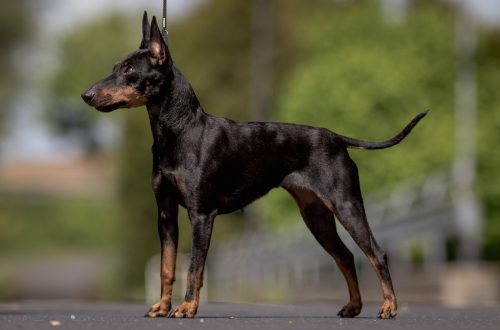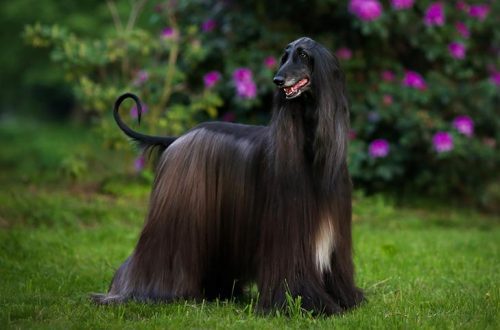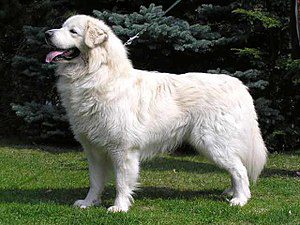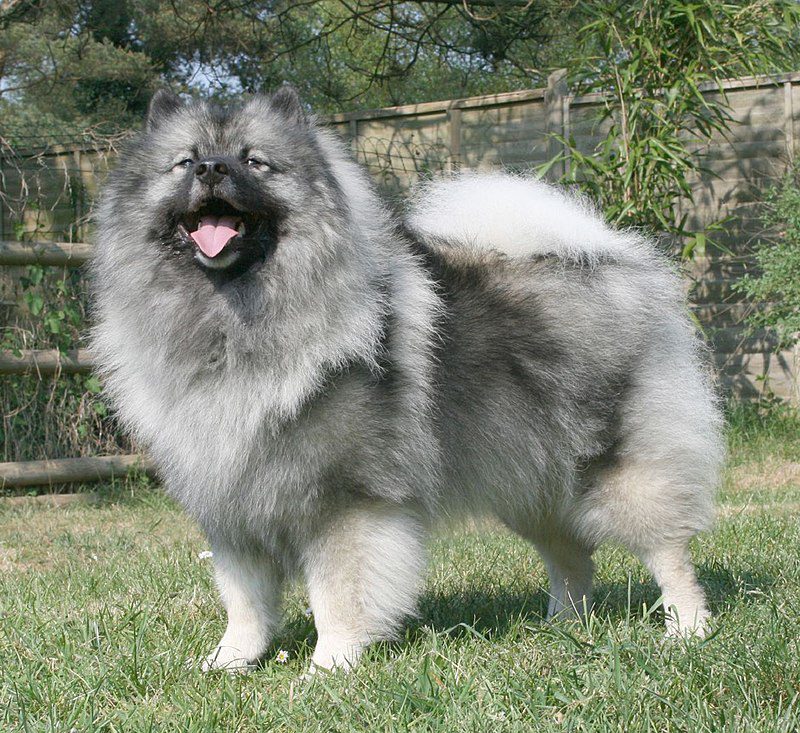
Keeshond
Contents
Characteristics of Keeshond
| Country of origin | Germany |
| The size | average |
| Growth | 43–55 cm |
| Weight | 25–30 kg |
| Age | 14–16 years old |
| FCI breed group | spitz and primitive breeds |
Basic moments
- Keeshonds are called the best friends of mushroom pickers, fishermen and picnic lovers, because dogs love outings into nature, during which they can run around and satisfy their curiosity.
- Even the minimum level of aggression is unusual for the breed, so it is easy for a pet to make friends with any stranger.
- Because of the touching expression of the muzzle, inherent in all representatives of the breed, Keeshonds are called “smiling Dutchmen.”
- The coat of Keeshonds, which are properly and systematically looked after, is devoid of an unpleasant canine odor.
- The breed is not afraid of water and willingly swims in open water in company with the owner.
- Energy and extroversion from Keeshonds gush like a fountain, so before you get such a dog, soberly assess your own capabilities.
- All descendants of the Wolfspitz are not averse to eating once again, and often the animals look into the bowl and beg for a tidbit just out of boredom.
- Keeshonds are smart and quick-witted dogs, but in Stanley Coren’s list of the smartest breeds, they are unfairly assigned 16th place.
- Bored and left alone for a long time, the Keeshond entertains itself with sonorous barking and howling, so careerists and workaholics who spend most of the day outside the home will not like such four-legged friends.
- The FCI does not recognize Keeshonds as an independent breed and uses the German Spitz standard to describe their appearance.
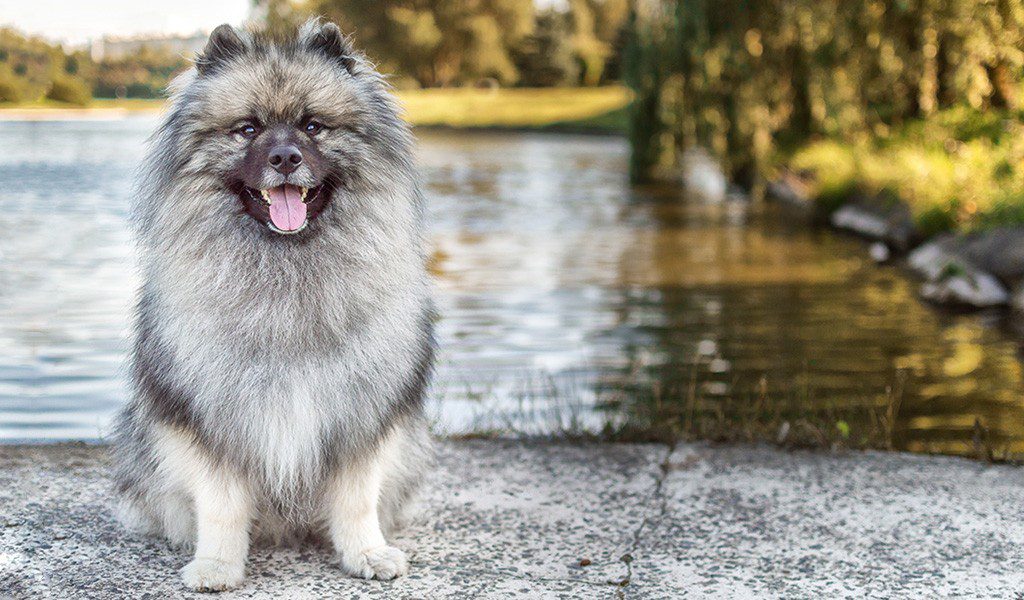
Keeshond is a charming shaggy with an endless battery of fun inside, with which the gloomiest day is colored into rainbow fireworks. This indefatigable fluffy is always sincerely happy about three things: communication with the owner, goodies in his own bowl and laid-back walks in nature. Try to satisfy these basic needs every day, according to the pet, and you will become the center of the universe for the Keeshond, and at the same time the most adored creature on the planet.
History of the Keeshond breed
At various dog shows, Keeshonds are usually presented as the Dutch “version” of the German Spitz , which has been one of the most common European breeds since the 16th century. Initially, the dogs did not have an aristocratic image, so the Wolfspitz played the role of ordinary mongrels: they hung around near the farms and vineyards of German peasants, occasionally barking at strangers who violated the territorial boundaries.
It is not known exactly how and when the ancestors of the Keeshonds emigrated to the Netherlands, but they settled down in a new place quickly and even managed to participate in the political life of the country – the breed was very respected by the leader of the local patriot party Cornelius de Gizelar. Subsequently, this involvement in the insurgency cost the lives of thousands of dogs, which were exterminated simply because they had previously had the misfortune to please the rebel. However, it was not possible to completely destroy the breed, and the Dutch Keeshonds continued to breed, gradually restoring their own numbers.
In 1880, German dog breeders standardized all varieties of Spitz, including Keeshonds. In the future, the development of the breed took place not so much in the Netherlands as in England, Sweden, Australia and the USA. As for the show career, for Keeshonds, it began in 1891, when several animals were presented at the Amsterdam exhibition. By that time, Wolfspitz from the Netherlands had been renamed “barge dogs” due to the fact that they often cut through the Dutch rivers with the owners of small boats.
In 1924, the first monobreed club, the Nederlandse Keeshond Club, began its work in the Netherlands, owing its opening to Baroness van Hardenbroek, who at that time was considered the largest breeder of barge dogs in the country. And two years later, the Dutch Keeshonds were registered by the Kennel Club of Great Britain.
In the USSR, dogs similar to Keeshonds appeared in the 1980s, but these were circus individuals that were not suitable for the role of breeding material. Fully breeding the breed in Russia began only in the mid-90s, and at first the wards of domestic breeders did not meet the standards of international cynological associations. As a result, in 1993, foreign champion manufacturers were brought into the country, from which part of today’s Keeshonds traces its pedigree.
Keeshond breed standard
Despite the fact that the FCI continues to see Keeshonds as a kind of Wolfspitz and allows exhibiting representatives of both families in the same ring, there are significant differences in the appearance and characters of the breeds, which are better to be aware of in advance. So, for example, Keeshonds, although they are considered the largest representatives in the Spitz group, are much more compact than their German cousins.
A more advantageous appearance is also an advantage of the “Dutch”, since at one time German breeders relied on practicality, preferring to develop working qualities in Wolfspitz rather than glamorous appearance. Breeds and colors differ. Keeshonds have a richer color palette of wool and includes gray, black and beige shades. But the fur coats of German Spitz have a traditional wolf color, in which the hairs have gray and black and white tones.
Going for a walk with a Keeshond, get ready that passersby will see a wide variety of breeds in your friend: from chow chow to caucasian shepherd dog . And the point here is not in cynological illiteracy, but in the unique feature of the “Dutch” at the same time to resemble representatives of several dog groups at once.
Head
The Keeshond has a medium-sized head, wide at the back of the head and acquiring a wedge-shaped shape in the muzzle area. The stop is smooth, turning into a harmonious short muzzle (the ratio of the length of the muzzle to the length of the cranial part of the head is 2:3).
Nose
All representatives of the breed have a round miniature earlobe of black color.
Jaws, lips
The medium-sized jaws of the Keeshond are closed either in a scissor or pincer bite (less preferred) bite. The lips of the dog are black, well fitting, without pronounced folds.
Eyes
Dark, obliquely set eyes are small and oval in shape. The eyelids of the animal are black.
Ears
The Keeshond’s tiny ears are triangular in shape and have a hard, pointed tip. The ear cloth is fixed in a vertical position, which gives the appearance of the dog a perky and mischievous look.
Neck
The necks of purebred representatives of the breed have a convex scruff, but are completely devoid of dewlap.
Frame
The high withers of the Keeshond pass into a wide short back, ending with the same short and massive croup. The chest of the animal is harmoniously developed, the stomach is slightly tucked up.
limbs
The Wolfspitz brothers have broad, straight legs with long shoulder blades and muscular thighs. The articulation angles are moderate, although the knee joints themselves are powerful. Metatarsus and metacarpus are strong, but not long. The paws of the Keeshond are small, “cat-like”, with black claws. The front paws are as round as possible, the hind legs are more oval.
Tail
The high-set tail of the dog at the base is turned up and forward and carried over the back.
Wool
Representatives of the Spitz clan, including the Keeshonds, have a double coat, formed by a plump layer of the thickest undercoat and a bristling integumentary hair. The tail and the area around the neck are most abundantly pubescent, which gives the silhouette of the dog a pleasant roundness.
Color
The FCI standard provides for Keeshonds the same type of color as for Wolfspitz (wolf). However, upon closer examination, it is noticeable that the “Dutch” has a richer shade of wool due to a small percentage of cream hairs (the hair of the Wolfspitz is silver-gray with a black tip).
The muzzle and ears of the dog are colored darker than the body. A black border of hairs is formed around the eyes, and above the eyes the same dark hair forms expressive eyebrows. The hair on the mane and shoulders of the Keeshond is lighter than in the body area. The limbs and panties at the hips are a refined silver-gray tone.
Disqualifying vices and breed defects
A Keeshond of any gender cannot participate in an exhibition if it has:
- semi-erect ears;
- rolled or everted eyelids;
- there are white spots on the coat;
- ungrown fontanel;
- there are deviations from the types of bite allowed by the standard;
- shy or aggressive behavior.
Individuals with obvious flaws in appearance that cast doubt on their pedigree cannot count on good grades. For example, Keeshonds with a flat or rounded apple-shaped skull. Animals with large bright eyes, a pink nose and an incomplete set of teeth are also considered defective, as are pets that do not have a pronounced black and gray “pattern” on the muzzle.
Character
Representatives of this breed are so fond of active games that they can play too much and accidentally damage the furniture in the house. They are very sociable and prefer to spend time in the company of a person. They often require increased attention to themselves, but they will not bother the owner, as they feel his mood very subtly, and at a difficult moment in life they can almost become a personal psychologist. Thanks to these qualities, Keeshonds are used in psychiatry to correct the behavior of sick people.
Dogs of this breed are characterized by good health and endurance: the Keeshond is able to withstand significant physical exertion, so it will be an ideal companion for those who love to play sports. For example, he can keep company during a long run or bike ride. And since he does not like to sit still, he will only be happy to communicate and activities in nature. Moreover, he needs a variety of physical activities to throw out energy. That is why a dog of this breed should not be taken by very busy people who are at work all day. Sitting at home all the time will not do this dog any good.
Keeshonds are very distrustful of strangers, which means that this quality can be used to develop the dog’s guarding abilities.
Behaviour
There will be no difficulties with training a pet, since this smart and quick-witted animal, trying to please the owner, will quickly master even complex tricks. But do not forget that these dogs are very sensitive to intonation: if you raise your voice during a Keeshond training, this will discourage him from any desire to practice.
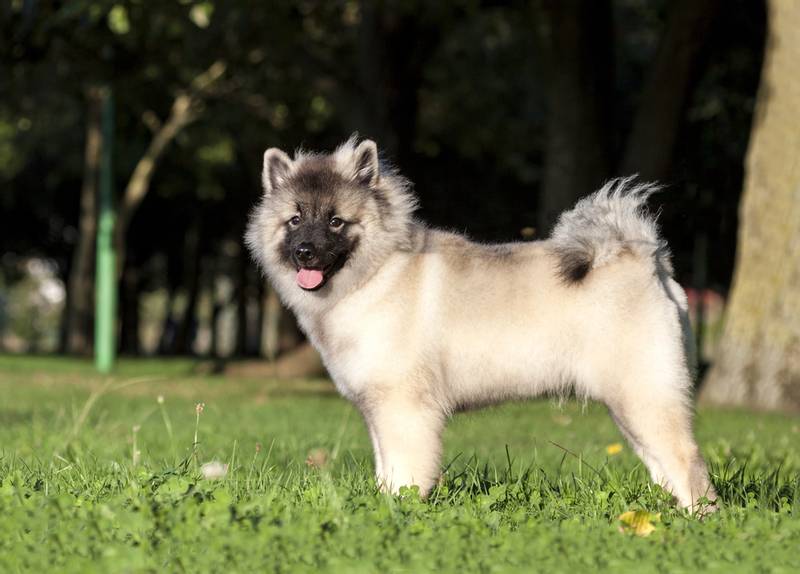
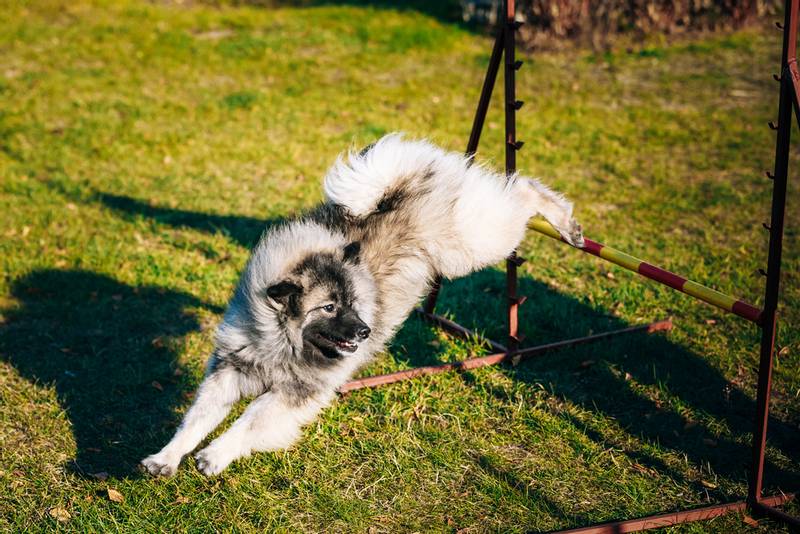
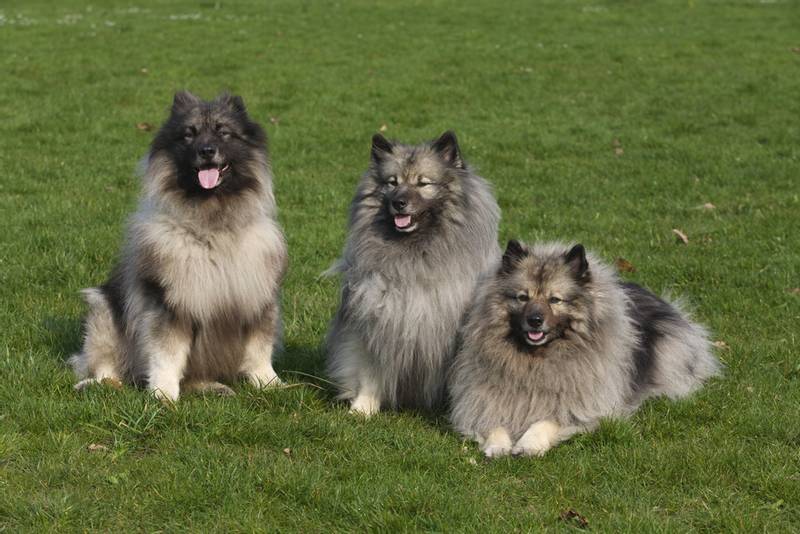
Education and training
If the Wolfspitz is a friend, ally and a little hard worker, faithfully guarding the master’s property, then his Dutch cousin is a smiling dog and a cheerful altruist, who should be gradually introduced to any work activity. And although the breed’s intelligence is more than okay, you still have to look for specific approaches to education and training.
Keep in mind that you can’t put pressure on Keeshonds and force them to do something under duress. Like all breeds, relatives of German Spitz cannot stand menacing shouts and overly importunate dominance of the owner. Moreover, this happens not because the dog wants to play the role of alpha itself, but because an unusual behavior model is imposed on it.
Remember also that the breed has not historically been a watchdog, and do not expect it to become one if a professional dog handler works with its representative. You can teach a Keeshond to bark at a stranger who has invaded your possessions, but to instill in him the aggression and suspicion of a “Caucasian” is an obviously impossible task. Accordingly, if you need a fluffy security guard with the makings of a defender, with such requirements it’s definitely not for Keeshonds.
It is possible and necessary to teach a four-legged prankster, but relying on his addictions. So instill in your pet basic skills in the game and do not delay the duration of the lessons. The best option is to break the lesson into five minutes, between which it is useful to maintain long pauses of 10-15 minutes. It is important to understand that the Keeshond is not a breed that will endure and perform dull exercises to please someone. Nevertheless, the animal will have enough strength and talent to deal with the intricacies of OKD and develop an interest in agility and freestyle if these disciplines are correctly and, most importantly, presented in an exciting way.
As for the rules of home etiquette, then the “Dutch” does not have any difficulties. Keeshonds are naturally clean, so they quickly learn how to use a tray or a diaper for their intended purpose and agree to endure in critical situations when access to an outdoor toilet is blocked. It is easy to wean a dog from harassing the owner and persistent calls to play if this is inconvenient for the owner. In such cases, you need to gently but firmly refuse the ward. Do not worry, the dog will not be stressed, the animal will simply switch its attention to another object or go to rest and wait for it to be called again.
Maintenance and care
The ancestors of the Keeshonds were ordinary yard dogs that lived in kennels, or even under the walls of sheds. Today, “smiling Dutch” are more often kept in homes, as it is easier to maintain their glamorous image. The only nuance that will have to be taken into account is the poor tolerance of animals to high temperatures. Having lived in the damp climate of Holland and Foggy Albion for too long, Keeshonds managed to adapt to it and now prefer pleasant coolness to the heat. By the way, this is another reason why it is undesirable to keep a dog in a city apartment – four-legged friends are demanding not only on the freedom of space, but also on the temperature regime, which in such rooms is difficult to adjust to the desired Keeshond level.
Hygiene
The coat of barge dogs acts as a natural thermostat, thanks to which the animals do not freeze on cool days and do not overheat in the heat. However, if the condition of the hair is not monitored, it quickly loses its magical properties. In particular, the Keeshond needs combing, without which its fur coat accumulates excess fat and gets dirty, thereby preventing air circulation in the layers of wool. But wolfspitz relatives practically do not form tangles, and this is already a significant plus for owners who do not want to burden themselves with daily care for a four-legged naughty.
Keeshond haircuts are contraindicated because they change the structure of the hair and expose the undercoat, making the body more vulnerable. An exception is made only for older individuals, who, due to their age, suffer more from high temperatures. True, it’s not worth getting too carried away here, and in general it’s more reasonable to choose a lion’s “hairstyle” for a dog that preserves the breed characteristics of appearance. For young and healthy animals, the hair is not shortened, but for hygienic reasons, the hairs are cut between the fingers and around the anal area.
The Keeshond outer coat sheds moderately throughout the year, so if you don’t want to find shaggy “traces” on the floor, do not neglect weekly combing. The undercoat also needs care. Once every six months, this natural “insulation” sheds profusely, so you need to get rid of it. By the way, it is undesirable to trim the animal. It is better to go over the fur coat with a fine comb or brush, the action of which can be enhanced with combing spray or antistatic from a pet store.
Surprisingly, you can maintain a stylish Keeshond image with little or no washing. Of course, if you are the owner of a show pet, you cannot do without an arsenal of shampoos, balms and conditioners, as well as without trips to the groomer. But most pets easily put up with the lack of bath days, so it is recommended to wash a fluffy friend using special pet products only if his coat is dirty and exudes unpleasant amber. In other cases, the shower is easy to replace with a thorough combing.
Keeshond eyes and ears are trouble-free, but periodic cleaning and wiping is necessary for them, so do not skimp on ophthalmic lotions and ear fluids. It is necessary to brush the dog’s teeth at least twice a week, and once a month the Keeshond is supposed to cut and polish its claws.
Feeding
Keeshond is still that lover to fill his stomach, but this is not a reason to be touched and feed a pet from a basin. The tendency to obesity in the breed is hereditary, so all attempts to please the dog with an additive and high-calorie delicacies lead to a set of extra pounds and trips to veterinary offices. The calorie content of the Keeshond diet should be of a pronounced seasonal nature. In winter, the “Dutchman” is obliged to receive more meat and offal (up to 500 g per day), but in summer it is more useful to unload the digestive tract with a modest 300 g of animal protein.
The standard weight of the Keeshond’s daily diet is 750-900 g. Usually, the menu includes the same products that are allowed for other dogs: cereals (oatmeal, buckwheat, rice), vegetables (except potatoes and broccoli), low-fat dairy products, egg yolks. A complete ban on consumption applies to any food from the master’s table, sweets, sausages and smoked meats, bones, raw fish, fruits (citrus fruits, grapes, pomegranates), semolina and fatty pork.
Usually puppies are distributed at two months of age, just at the time when babies can be transferred to four meals a day. Further, the need to reduce the number of meals of the animal falls entirely on the owner. By the way, do not forget that a 9-month-old Keeshond should eat no more than twice a day.
For owners who prefer to keep their pets on dry food, we can recommend super-premium and holistic-class brands, and special attention should be paid to cereals in the composition, which should be as small as possible in the “drying”. It is normal if rice grains (white or brown) are included in the feed and not very good if the main cereal supplement is wheat. Another important nuance: some expensive foods can affect the shade of the Keeshond’s coat, which can be a serious nuisance for the owners of show individuals – at the exhibition, the tone of the dog’s coat is meticulously examined.
Keeshond health and disease
There is an opinion that, unlike Wolfspitz, Keeshonds suffered less from breeding experiments and, accordingly, have better health. However, the breed has several serious ailments due to heredity. One of them is hip dysplasia. The disease is transmitted from producers to offspring, so breeders who value their reputation examine the breed individuals for the presence of this disease.
Subluxation of the patella, which is often found in Keeshonds, can be both genetic in nature and mechanical. Often the disease develops as a result of an injury that was not noticed in a timely manner by the owner. Some representatives of the breed may have von Willebrand disease – a violation of the process of blood clotting.
Malfunctions in the thyroid gland and an insufficient amount of hormones produced by it lead to the development of hypothyroidism, which Keeshond puppies inherit from their parents. But epilepsy, which a few decades ago was considered the scourge of the breed, is becoming less common today. However, when buying a puppy, it would be useful to clarify information about epileptic seizures in a bitch and a stud dog.
How to choose a puppy
- Choosing a Keeshond puppy by gender is pointless. Representatives of this breed do not have pronounced “girl” and “boy” character traits. At the same time, males are endowed with a more textured appearance, while bitches are distinguished by a pleasant grace of physique.
- Ask the breeder about the results of the examination of offspring producers for genetic ailments – dysplasia, patella, hypothyroidism.
- Look for a breeder who is ready to give away a puppy no earlier than he is 8 weeks old – at this age, the kids are ready to painlessly part with their mother and brothers.
- Assess the conditions for keeping Keeshonds, giving preference to nurseries where they practice suburban cultivation and do not lock animals in cages and cramped apartments.
- If you’re looking to get a show dog, look for breeders that offer 4 month old puppies. At this age, the show potential of the Keeshond is better seen.
- Pay special attention to the color of the puppy. Expand the coat, evaluate the thickness and uniformity of the undercoat and immediately refuse to buy if even a miniature white speck is found on the fur coat – this is a serious defect that casts doubt on the breed of the litter.
Keeshond price
A Keeshond puppy from titled producers with the brand of a well-known nursery will cost 800 – 900$. The average representative of the breed, who does not have an outstanding appearance, but is suitable for the role of a pet, is an average of 350 – 450$. Sometimes “super-profitable” ads pop up on websites and forums offering Keeshonds for 150$ – 250$. Usually, at low prices, either animals that are not entirely successful in aesthetic terms, or offspring from not too healthy, or even unexamined producers, come true.
Keeshond – Video





